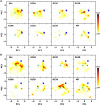Assessment of mutation probabilities of KRAS G12 missense mutants and their long-timescale dynamics by atomistic molecular simulations and Markov state modeling
- PMID: 30199525
- PMCID: PMC6147662
- DOI: 10.1371/journal.pcbi.1006458
Assessment of mutation probabilities of KRAS G12 missense mutants and their long-timescale dynamics by atomistic molecular simulations and Markov state modeling
Abstract
A mutated KRAS protein is frequently observed in human cancers. Traditionally, the oncogenic properties of KRAS missense mutants at position 12 (G12X) have been considered as equal. Here, by assessing the probabilities of occurrence of all KRAS G12X mutations and KRAS dynamics we show that this assumption does not hold true. Instead, our findings revealed an outstanding mutational bias. We conducted a thorough mutational analysis of KRAS G12X mutations and assessed to what extent the observed mutation frequencies follow a random distribution. Unique tissue-specific frequencies are displayed with specific mutations, especially with G12R, which cannot be explained by random probabilities. To clarify the underlying causes for the nonrandom probabilities, we conducted extensive atomistic molecular dynamics simulations (170 μs) to study the differences of G12X mutations on a molecular level. The simulations revealed an allosteric hydrophobic signaling network in KRAS, and that protein dynamics is altered among the G12X mutants and as such differs from the wild-type and is mutation-specific. The shift in long-timescale conformational dynamics was confirmed with Markov state modeling. A G12X mutation was found to modify KRAS dynamics in an allosteric way, which is especially manifested in the switch regions that are responsible for the effector protein binding. The findings provide a basis to understand better the oncogenic properties of KRAS G12X mutants and the consequences of the observed nonrandom frequencies of specific G12X mutations.
Conflict of interest statement
The authors have declared that no competing interests exist.
Figures





References
-
- Trahey M, McCormick F. A cytoplasmic protein stimulates normal N-RAS p21 GTPase, but does not affect oncogenic mutants. Science 1987; 238:542–545 - PubMed
Publication types
MeSH terms
Substances
LinkOut - more resources
Full Text Sources
Other Literature Sources
Miscellaneous

